Jun Han
CD-TVD: Contrastive Diffusion for 3D Super-Resolution with Scarce High-Resolution Time-Varying Data
Aug 13, 2025Abstract:Large-scale scientific simulations require significant resources to generate high-resolution time-varying data (TVD). While super-resolution is an efficient post-processing strategy to reduce costs, existing methods rely on a large amount of HR training data, limiting their applicability to diverse simulation scenarios. To address this constraint, we proposed CD-TVD, a novel framework that combines contrastive learning and an improved diffusion-based super-resolution model to achieve accurate 3D super-resolution from limited time-step high-resolution data. During pre-training on historical simulation data, the contrastive encoder and diffusion superresolution modules learn degradation patterns and detailed features of high-resolution and low-resolution samples. In the training phase, the improved diffusion model with a local attention mechanism is fine-tuned using only one newly generated high-resolution timestep, leveraging the degradation knowledge learned by the encoder. This design minimizes the reliance on large-scale high-resolution datasets while maintaining the capability to recover fine-grained details. Experimental results on fluid and atmospheric simulation datasets confirm that CD-TVD delivers accurate and resource-efficient 3D super-resolution, marking a significant advancement in data augmentation for large-scale scientific simulations. The code is available at https://github.com/Xin-Gao-private/CD-TVD.
FinGAIA: An End-to-End Benchmark for Evaluating AI Agents in Finance
Jul 23, 2025



Abstract:The booming development of AI agents presents unprecedented opportunities for automating complex tasks across various domains. However, their multi-step, multi-tool collaboration capabilities in the financial sector remain underexplored. This paper introduces FinGAIA, an end-to-end benchmark designed to evaluate the practical abilities of AI agents in the financial domain. FinGAIA comprises 407 meticulously crafted tasks, spanning seven major financial sub-domains: securities, funds, banking, insurance, futures, trusts, and asset management. These tasks are organized into three hierarchical levels of scenario depth: basic business analysis, asset decision support, and strategic risk management. We evaluated 10 mainstream AI agents in a zero-shot setting. The best-performing agent, ChatGPT, achieved an overall accuracy of 48.9\%, which, while superior to non-professionals, still lags financial experts by over 35 percentage points. Error analysis has revealed five recurring failure patterns: Cross-modal Alignment Deficiency, Financial Terminological Bias, Operational Process Awareness Barrier, among others. These patterns point to crucial directions for future research. Our work provides the first agent benchmark closely related to the financial domain, aiming to objectively assess and promote the development of agents in this crucial field. Partial data is available at https://github.com/SUFE-AIFLM-Lab/FinGAIA.
TexGS-VolVis: Expressive Scene Editing for Volume Visualization via Textured Gaussian Splatting
Jul 18, 2025Abstract:Advancements in volume visualization (VolVis) focus on extracting insights from 3D volumetric data by generating visually compelling renderings that reveal complex internal structures. Existing VolVis approaches have explored non-photorealistic rendering techniques to enhance the clarity, expressiveness, and informativeness of visual communication. While effective, these methods often rely on complex predefined rules and are limited to transferring a single style, restricting their flexibility. To overcome these limitations, we advocate the representation of VolVis scenes using differentiable Gaussian primitives combined with pretrained large models to enable arbitrary style transfer and real-time rendering. However, conventional 3D Gaussian primitives tightly couple geometry and appearance, leading to suboptimal stylization results. To address this, we introduce TexGS-VolVis, a textured Gaussian splatting framework for VolVis. TexGS-VolVis employs 2D Gaussian primitives, extending each Gaussian with additional texture and shading attributes, resulting in higher-quality, geometry-consistent stylization and enhanced lighting control during inference. Despite these improvements, achieving flexible and controllable scene editing remains challenging. To further enhance stylization, we develop image- and text-driven non-photorealistic scene editing tailored for TexGS-VolVis and 2D-lift-3D segmentation to enable partial editing with fine-grained control. We evaluate TexGS-VolVis both qualitatively and quantitatively across various volume rendering scenes, demonstrating its superiority over existing methods in terms of efficiency, visual quality, and editing flexibility.
DeTrigger: A Gradient-Centric Approach to Backdoor Attack Mitigation in Federated Learning
Nov 19, 2024



Abstract:Federated Learning (FL) enables collaborative model training across distributed devices while preserving local data privacy, making it ideal for mobile and embedded systems. However, the decentralized nature of FL also opens vulnerabilities to model poisoning attacks, particularly backdoor attacks, where adversaries implant trigger patterns to manipulate model predictions. In this paper, we propose DeTrigger, a scalable and efficient backdoor-robust federated learning framework that leverages insights from adversarial attack methodologies. By employing gradient analysis with temperature scaling, DeTrigger detects and isolates backdoor triggers, allowing for precise model weight pruning of backdoor activations without sacrificing benign model knowledge. Extensive evaluations across four widely used datasets demonstrate that DeTrigger achieves up to 251x faster detection than traditional methods and mitigates backdoor attacks by up to 98.9%, with minimal impact on global model accuracy. Our findings establish DeTrigger as a robust and scalable solution to protect federated learning environments against sophisticated backdoor threats.
Guided Discrete Diffusion for Electronic Health Record Generation
Apr 18, 2024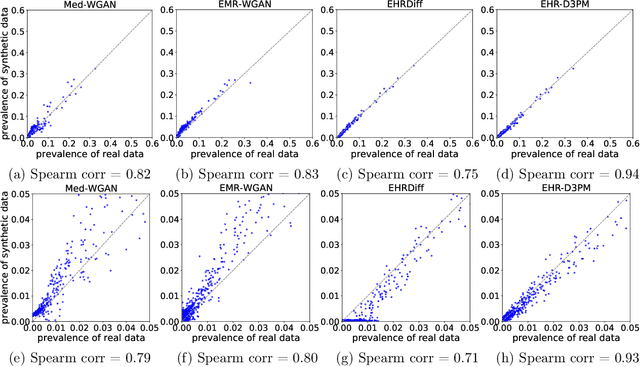



Abstract:Electronic health records (EHRs) are a pivotal data source that enables numerous applications in computational medicine, e.g., disease progression prediction, clinical trial design, and health economics and outcomes research. Despite wide usability, their sensitive nature raises privacy and confidentially concerns, which limit potential use cases. To tackle these challenges, we explore the use of generative models to synthesize artificial, yet realistic EHRs. While diffusion-based methods have recently demonstrated state-of-the-art performance in generating other data modalities and overcome the training instability and mode collapse issues that plague previous GAN-based approaches, their applications in EHR generation remain underexplored. The discrete nature of tabular medical code data in EHRs poses challenges for high-quality data generation, especially for continuous diffusion models. To this end, we introduce a novel tabular EHR generation method, EHR-D3PM, which enables both unconditional and conditional generation using the discrete diffusion model. Our experiments demonstrate that EHR-D3PM significantly outperforms existing generative baselines on comprehensive fidelity and utility metrics while maintaining less membership vulnerability risks. Furthermore, we show EHR-D3PM is effective as a data augmentation method and enhances performance on downstream tasks when combined with real data.
SingVisio: Visual Analytics of Diffusion Model for Singing Voice Conversion
Feb 20, 2024



Abstract:In this study, we present SingVisio, an interactive visual analysis system that aims to explain the diffusion model used in singing voice conversion. SingVisio provides a visual display of the generation process in diffusion models, showcasing the step-by-step denoising of the noisy spectrum and its transformation into a clean spectrum that captures the desired singer's timbre. The system also facilitates side-by-side comparisons of different conditions, such as source content, melody, and target timbre, highlighting the impact of these conditions on the diffusion generation process and resulting conversions. Through comprehensive evaluations, SingVisio demonstrates its effectiveness in terms of system design, functionality, explainability, and user-friendliness. It offers users of various backgrounds valuable learning experiences and insights into the diffusion model for singing voice conversion.
Amphion: An Open-Source Audio, Music and Speech Generation Toolkit
Dec 15, 2023

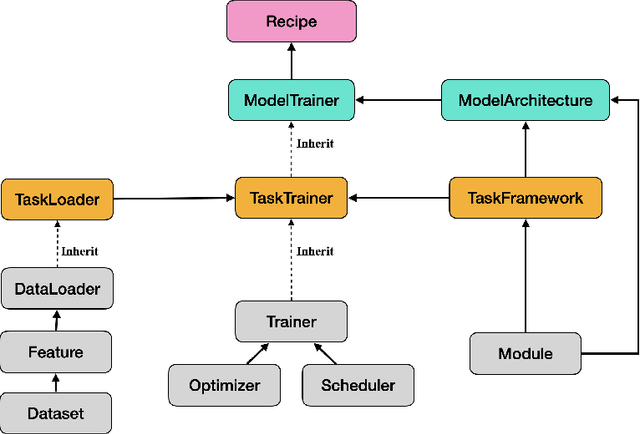

Abstract:Amphion is a toolkit for Audio, Music, and Speech Generation. Its purpose is to support reproducible research and help junior researchers and engineers get started in the field of audio, music, and speech generation research and development. Amphion offers a unique feature: visualizations of classic models or architectures. We believe that these visualizations are beneficial for junior researchers and engineers who wish to gain a better understanding of the model. The North-Star objective of Amphion is to offer a platform for studying the conversion of any inputs into general audio. Amphion is designed to support individual generation tasks. In addition to the specific generation tasks, Amphion also includes several vocoders and evaluation metrics. A vocoder is an important module for producing high-quality audio signals, while evaluation metrics are critical for ensuring consistent metrics in generation tasks. In this paper, we provide a high-level overview of Amphion.
Contextual Object Detection with Multimodal Large Language Models
May 29, 2023Abstract:Recent Multimodal Large Language Models (MLLMs) are remarkable in vision-language tasks, such as image captioning and question answering, but lack the essential perception ability, i.e., object detection. In this work, we address this limitation by introducing a novel research problem of contextual object detection -- understanding visible objects within different human-AI interactive contexts. Three representative scenarios are investigated, including the language cloze test, visual captioning, and question answering. Moreover, we present ContextDET, a unified multimodal model that is capable of end-to-end differentiable modeling of visual-language contexts, so as to locate, identify, and associate visual objects with language inputs for human-AI interaction. Our ContextDET involves three key submodels: (i) a visual encoder for extracting visual representations, (ii) a pre-trained LLM for multimodal context decoding, and (iii) a visual decoder for predicting bounding boxes given contextual object words. The new generate-then-detect framework enables us to detect object words within human vocabulary. Extensive experiments show the advantages of ContextDET on our proposed CODE benchmark, open-vocabulary detection, and referring image segmentation. Github: https://github.com/yuhangzang/ContextDET.
Projected Gradient Descent Algorithms for Solving Nonlinear Inverse Problems with Generative Priors
Sep 21, 2022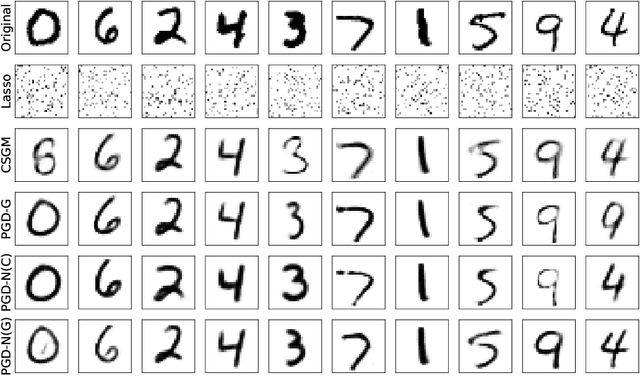
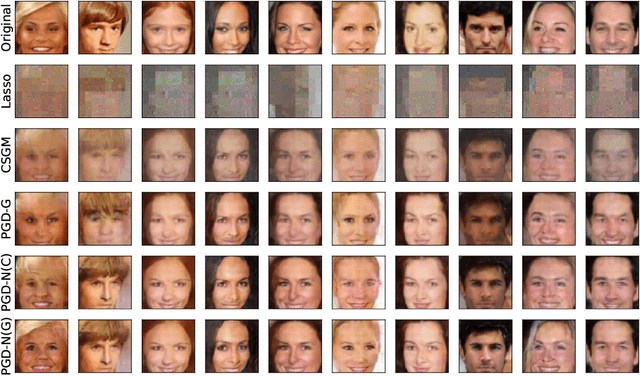
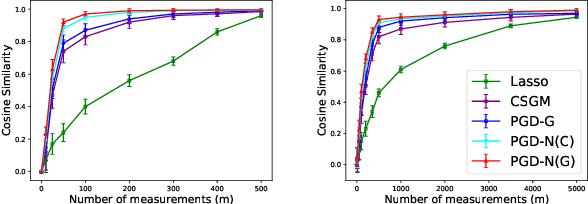
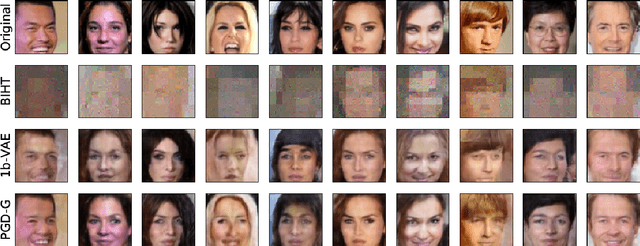
Abstract:In this paper, we propose projected gradient descent (PGD) algorithms for signal estimation from noisy nonlinear measurements. We assume that the unknown $p$-dimensional signal lies near the range of an $L$-Lipschitz continuous generative model with bounded $k$-dimensional inputs. In particular, we consider two cases when the nonlinear link function is either unknown or known. For unknown nonlinearity, similarly to \cite{liu2020generalized}, we make the assumption of sub-Gaussian observations and propose a linear least-squares estimator. We show that when there is no representation error and the sensing vectors are Gaussian, roughly $O(k \log L)$ samples suffice to ensure that a PGD algorithm converges linearly to a point achieving the optimal statistical rate using arbitrary initialization. For known nonlinearity, we assume monotonicity as in \cite{yang2016sparse}, and make much weaker assumptions on the sensing vectors and allow for representation error. We propose a nonlinear least-squares estimator that is guaranteed to enjoy an optimal statistical rate. A corresponding PGD algorithm is provided and is shown to also converge linearly to the estimator using arbitrary initialization. In addition, we present experimental results on image datasets to demonstrate the performance of our PGD algorithms.
DL4SciVis: A State-of-the-Art Survey on Deep Learning for Scientific Visualization
Apr 13, 2022



Abstract:Since 2016, we have witnessed the tremendous growth of artificial intelligence+visualization (AI+VIS) research. However, existing survey papers on AI+VIS focus on visual analytics and information visualization, not scientific visualization (SciVis). In this paper, we survey related deep learning (DL) works in SciVis, specifically in the direction of DL4SciVis: designing DL solutions for solving SciVis problems. To stay focused, we primarily consider works that handle scalar and vector field data but exclude mesh data. We classify and discuss these works along six dimensions: domain setting, research task, learning type, network architecture, loss function, and evaluation metric. The paper concludes with a discussion of the remaining gaps to fill along the discussed dimensions and the grand challenges we need to tackle as a community. This state-of-the-art survey guides SciVis researchers in gaining an overview of this emerging topic and points out future directions to grow this research.
 Add to Chrome
Add to Chrome Add to Firefox
Add to Firefox Add to Edge
Add to Edge